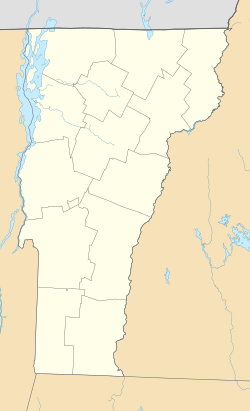Fenn Farm facts for kids
Quick facts for kids |
|
|
Fenn Farm
|
|
| Location | VT 116 (Case St.), W side, Middlebury, Vermont |
|---|---|
| Area | 94 acres (38 ha) |
| Built | 1828 |
| MPS | Agricultural Resources of Vermont MPS |
| NRHP reference No. | 94001518 |
| Added to NRHP | January 6, 1995 |
Fenn Farm is a very old farm located on Case Street in Middlebury, Vermont. It started around 1828 as a sheep farm. Over time, it grew and changed what it produced. Today, it still has many farm buildings from the mid-1800s that are in great condition. Because of its history, Fenn Farm was added to the National Register of Historic Places in 1995. This means it's an important historical site.
Contents
What is Fenn Farm Like?
Fenn Farm is in the countryside part of Middlebury. It covers about 100 acres (about 40 hectares) of land. This land stretches out on both sides of Case Street, which is also known as Vermont Route 116.
The Farm's Landscape
The farm has gentle rolling hills. These hills are used for different things. Some parts are pastures where animals can graze. Other parts are used for growing crops. There are also areas covered in woodland.
Farm Buildings and Their History
The main farm buildings are grouped together on the west side of Case Street. The oldest part of the farmhouse is a small, one-and-a-half story wooden house. It was built by 1840, and maybe even as early as 1828. Over the years, more rooms were added to the back of the house.
Other old buildings on the farm include:
- A horse barn and a granary (where grain is stored) built around 1860.
- A piggery (a place for pigs) built around 1880.
More modern buildings were added in the 1900s. These include a hen house for chickens, a milk house for dairy products, and a tall, round silo for storing animal feed.
Who Lived and Worked at Fenn Farm?
The land for Fenn Farm was first cleared around 1828. A person named Silas Torrance started the farm. He focused on raising sheep.
Changes Over Time
By 1850, Daniel Sessions owned the farm. At this time, the farm grew more diverse. Besides wool from sheep, it also produced grain and dairy products like milk and cheese.
In 1854, James Fenn bought the property. His family has owned Fenn Farm ever since! This means the farm has been in the same family for a very long time.
Focus on Dairy and Chickens
In the early 1900s, the farm started to focus much more on producing dairy products. Later, in the 1980s, a hen house was built. This helped the farm produce more chickens and eggs.
Fenn Farm shows how farms in Vermont have changed over many years. It started with sheep, then added grains and dairy, and later focused on dairy and chickens.



